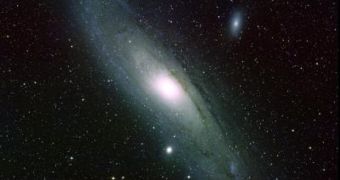Studies conducted on the nearby Andromeda Galaxy have revealed that the outermost edges of the galaxy are spinning increasingly fast, which is something that existing models cannot account for.
Astronomers already need the concept of dark matter to explain why the rotation curves of known galaxies are constant, when the basic laws of physics dictate otherwise.
For a very long time, researchers believed that the rotation curves of galaxies should resemble those of the solar system, in which the planets closer to the Sun spin fastest.
Conversely, the four gas giants and the objects in the Kuiper Belt spin slower around the star. A similar ratio was expected by early astronomers when thy first calculated galactic rotation curves.
But they discovered that the rate was surprisingly constant, which meant that the visible portion of the galaxy was only a fragment of its total mass. Dark matter was born to explain this phenomenon.
The main explanation for this in the astrophysics community today is that the elusive stuff is keeping galaxies so tightly packed together, that they are forced to spin around their cores like a solid object.
But the new studies that were conducted on Andromeda Galaxy and on other cosmic structures do not fit this model. Data shows that the rotation rate in the outermost layers of these galaxies is increasing.
The paper, which was authored by astronomers in Spain, seeks to provide an explanation for this discrepancy, Universe Today reports.
Researchers B. Ruiz-Granados and J.A. Rubino-Martin, who are both based at the Instituto de Astrofisica de Canarias (IAC), say that magnetic fields can be used to explain the odd readings.
Advanced studies of Andromeda, also known as M31, shows that magnetic fields decrease in intensity less rapidly than other factors that may influence the rotation speed, such as dark matter.
The researchers additionally found that the magnetic fields in M31 slowly change their angle in respect to the center of the galaxy the further they get from their core.
This is maybe why “the field becomes more tightly wound with increasing galactocentric distance,” the researchers say. A direct consequence is that the decrease in strength becomes even slower.
While the addition of magnetic field to existing computer models makes predictions come more in touch with the observed reality, the team says that the nature of these findings is still speculative.
At this point, there is no way of analyzing such massive magnetic fields other than through computer simulations. But planned telescopes such as LOFAR and SKA could carry out this type of studies.

 14 DAY TRIAL //
14 DAY TRIAL //